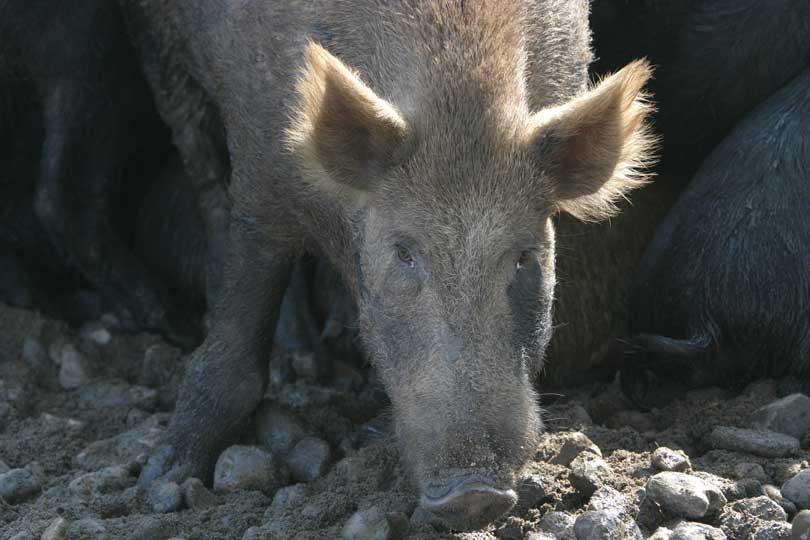By Gary Joiner
TFB Radio Network Manager
The Texas A&M Natural Resources Institute (NRI) encourages Texas landowners and homeowners to report sightings of wild pigs and any damage they may have caused.
“Landowners are constantly seeing wild pigs, seeing their damage, but there’s not a good way to collect their information about where that occurs,” Dr. Jim Cathey, NRI associate director, told the Texas Farm Bureau Radio Network.
The website brings together the new reporting tool with past products that provide landowners with information on how to remove wild pigs from their property.
“On our wild pig website, it takes one through a process where it allows you to tell us your name, your location,” Cathey said. “We even have a map where you just move your cursor across the map, click it, and it will tell your latitude and longitude.”
Cathey said damage information helps with management decisions and where abatement efforts need to be targeted.
“The person that is providing the report can tell us the number of pigs they see, the different classes, whether it’s male, female or young. And then they can also click buttons to tell us about the type of damage that occurs, whether that’s wallowing, rooting, tearing up fences or infrastructure,” he said. “All those are easy selections that the user can make for us.”
The new tool also includes a section for photo submissions.
Examples of wild pig damage include vehicle collisions, habitat loss, livestock depredation, disease transmissions, bacterial impairments and more.
Past data from Texas landowners indicates wild pigs cause an estimated $52 million in agricultural damage annually in the state.
He noted wild pigs cause tremendous damage to row crops, pastures, agricultural equipment and more.
Nationally, damage from wild pigs is estimated at $1.5 billion. Cathey said the estimates, however, don’t include information about the damage that occurs in now suburban areas of Texas.
As the state’s population continues to expand, Cathey said issues with wild pigs in urban and suburban areas are also a growing concern.
“We have wild pigs in Houston, Dallas, Austin, San Antonio,” he said. “Damage to the landscapes, whether it be to irrigation or to the plants themselves around home sites, that can get pretty expensive, as well.”
The new reporting tool will also allow wildlife researchers to see where wild pigs may be harming water quality and stream systems.
“They cause problems through rooting. They increase the sedimentation, and they actually defecate straight into the stream systems, increasing E-coli and making those streams unsafe for us to recreate in,” Cathey said. “This allows us an opportunity to work with agencies, such as Texas Wildlife Services, to come and do abatement, primarily through aerial gunning or some other control measures.”
To learn more and report information, visit https://wildpigs.nri.tamu.edu.


My ranch is south of Brookshire (37 miles west of Houston).
We have pigs almost every night for the last 4 to 5 years.
We have shot many but they keep coming.
The have torn up all of my pastures & it seems there is no stopping them.
I’d just say they are all over Texas…..
Tried to look at the link and got tired of waiting for it to open. If it takes too long to even access the site the tool is no help to me.
It didn’t take long for it to load for me. Might try refreshing your web browser.
We have had them for sometime. They have torn up fences,messed up my stock ponds up, chased after my horses off feed, went into my barn got into feed on pallets yes over a ton at a time and tore up the sepic system a number of times. I’ve hunted them too the point i need a ar15. Its been a nightmare. Only good i say the little ones bbq good.
We are 4 miles north of Hillsboro. We trapped 10 in the last 3 weeks. They damaged our corn field and are damaging pastures.
We were able to get rid of 58 on our farm in September! We hired a man with a suspended trap. He could track their activity with a camera. It was a huge help.
Wild hogs in Clay County tx destroyed our wheat field, land looks like bomb set off with all holes they have dug. We can’t drive or ride horses on it. .last year they got into our wheat hay and destroyed Over 100 bales. We try shooting and trapping but they just keep multiplying .
I wish to come to texas to kill these things I live in washington. If anyone wants to let me kill these things. I’m willing to help any way possible. Please contact me, thank you
There are literally 1,000’s of feral pigs in Hunt Co., especially along the Sabine and Sulpher River drainages but also on smaller creeks/drainages,farmland,thickets. We hunt and trap them to no end but the population continues to expand. I have leased land in Sabine river bottom since 2002 and they have decimated the land and wildlife there. I have hunted them since the mid 1980’s starting in the Sulphur River bottoms.